The next morning I had a chance to observe the various views from our room
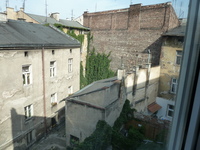
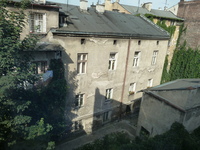
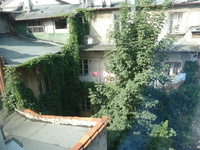
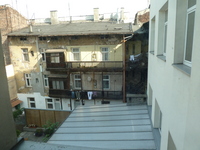 before we went down for breakfast and I filled my plate
before we went down for breakfast and I filled my plate
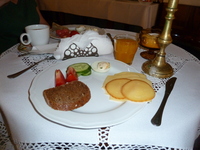 as Suzanne filled hers
as Suzanne filled hers
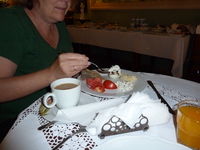 and she
and she
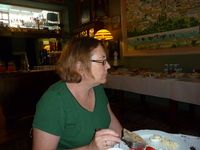 and I posed for portraits
and I posed for portraits
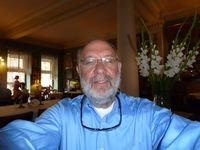 before I explored and found signs for the hotel on their patio.
before I explored and found signs for the hotel on their patio.
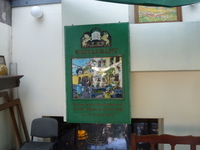
 We greeted Mitch, Kathleen and Liam
We greeted Mitch, Kathleen and Liam
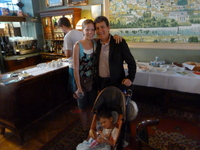 before being introduced to the group and walking through our neighborhood
before being introduced to the group and walking through our neighborhood
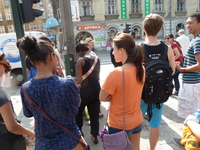
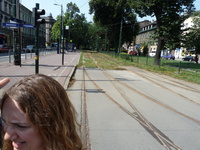
 until we arrived at the gift shop
until we arrived at the gift shop
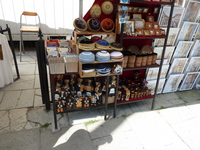 outside the Remuh Synagogue
outside the Remuh Synagogue
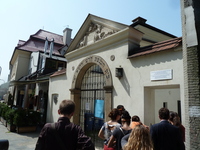 and we made our way past the memorials
and we made our way past the memorials
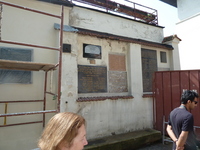
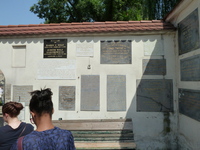 into the sanctuary
into the sanctuary
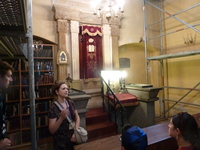
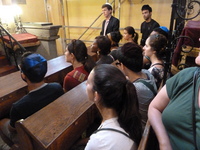 with the bemah in the middle
with the bemah in the middle
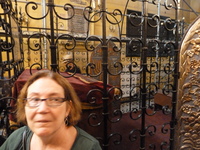 and the ark with Torah scrolls
and the ark with Torah scrolls
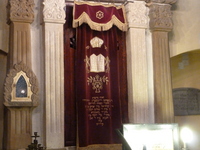 and a poster above the bemah giving the words to the aliyah
and a poster above the bemah giving the words to the aliyah
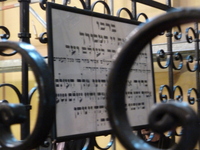 as we left the bemah
as we left the bemah
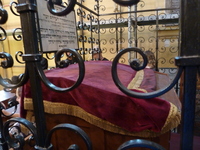 and headed to the cemetery where we saw the grave stone of the famous Rebe complete with notes left and stones of visitors
and headed to the cemetery where we saw the grave stone of the famous Rebe complete with notes left and stones of visitors
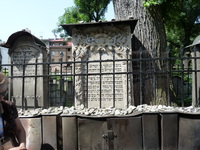
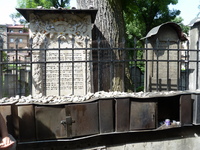
 and then explored the tombstones as
and then explored the tombstones as

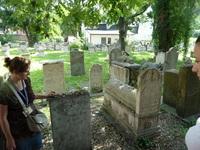
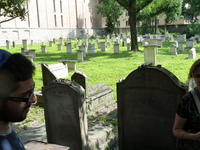 as our guide focused on our tombstone and explained the significance of what was written on it
as our guide focused on our tombstone and explained the significance of what was written on it
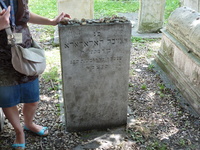 and we then made our way through the cemetery
and we then made our way through the cemetery
to the wall that was constructed of pieces of gravestones that had been broken by the Nazis. Note that the Nazis made no attempt to destroy the cemetery; instead they used it as a garbage dump because they knew this would be more insulting to the Jews.
|
At the wall, I took some broad photos of the whole cemetery
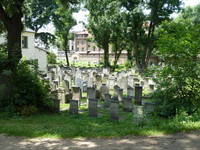

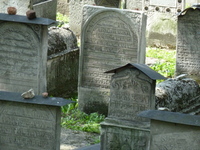 and then saw some pieces of stones corresponding to Kahanim (and hence the hands).
and then saw some pieces of stones corresponding to Kahanim (and hence the hands).
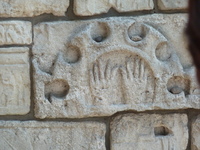
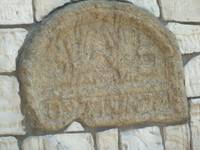 on the way out, I recorded this sad memorial
on the way out, I recorded this sad memorial
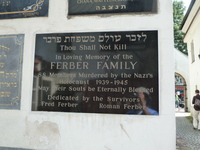 and we headed to the town's memorial to the Jews who had perished
and we headed to the town's memorial to the Jews who had perished

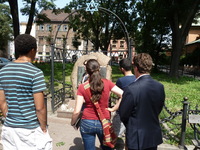 and the square (which is now filled with shops and restaurants largely owned by non-Jews)
and the square (which is now filled with shops and restaurants largely owned by non-Jews)
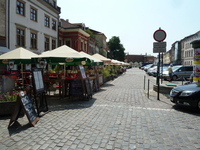 and the synagogue
and the synagogue
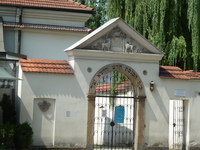 before capturing a final shot of the memorial
before capturing a final shot of the memorial
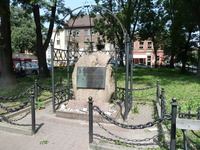 and heading across the river to this plaza where the chairs had a special significance as I was to learn
and heading across the river to this plaza where the chairs had a special significance as I was to learn
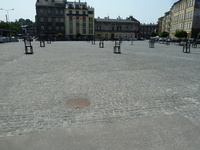 but first I noted this street scene which was the location of the resistance
but first I noted this street scene which was the location of the resistance
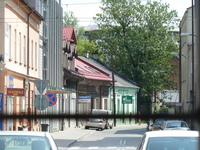 as our group came onto the square which was at the heart of the ghetto
as our group came onto the square which was at the heart of the ghetto

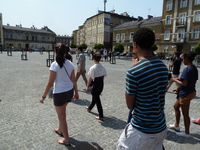 as we left this structure which had served as the police station for the Nazis who oversaw the ghetto
as we left this structure which had served as the police station for the Nazis who oversaw the ghetto
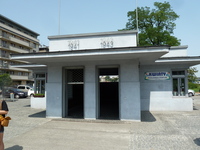 and it was here that I learned that the chairs were an art installation dedicated to those who had been killed by the Nazis
and it was here that I learned that the chairs were an art installation dedicated to those who had been killed by the Nazis

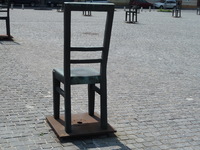 and we then walked down the street
and we then walked down the street
 and took the obligatory phone booth picture
and took the obligatory phone booth picture
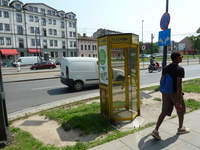 before we came to this sign
before we came to this sign
 defining the ghetto wall which had been made to look like tombstones to signify tot he Jews that this was their end.
defining the ghetto wall which had been made to look like tombstones to signify tot he Jews that this was their end.
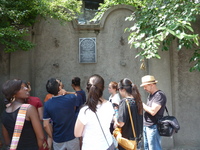

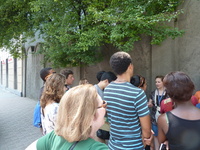 We were also shown windows that were bricked over as they were on buildings that were part of the ghetto and so could not have views to the outside
We were also shown windows that were bricked over as they were on buildings that were part of the ghetto and so could not have views to the outside
 and as we walked
and as we walked
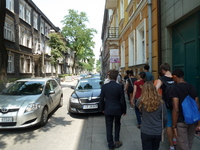 this sign seemed like an odd juxtaposition of the past and the present (or future)
this sign seemed like an odd juxtaposition of the past and the present (or future)
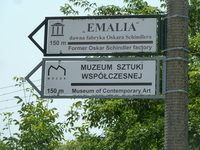 and so we made our way to Oskar Schindler's factory
and so we made our way to Oskar Schindler's factory
 and saw the names of those he had saved
and saw the names of those he had saved

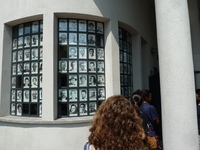
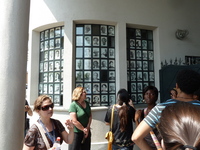 before entering the museum
before entering the museum
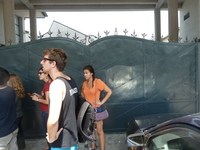 noting the price guide
noting the price guide
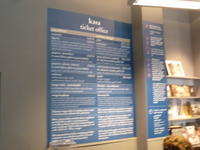 and having some water, it being a hot day,
and having some water, it being a hot day,
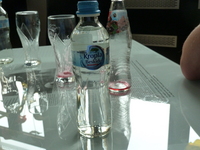 and seeing the kosher statement (which had just expired) for the coffee.
and seeing the kosher statement (which had just expired) for the coffee.
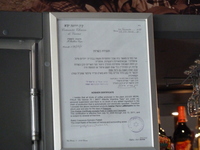
The museum traced the history of Poland and Krakow through the war beginning in 1939
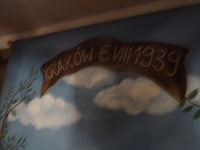 as our tour guide explained the premise which we didn't grasp for a few rooms.
as our tour guide explained the premise which we didn't grasp for a few rooms.
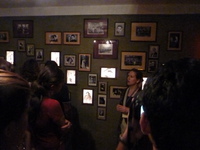 We began with war gear
We began with war gear
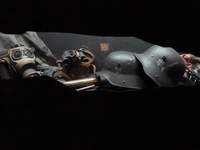 and uniforms
and uniforms
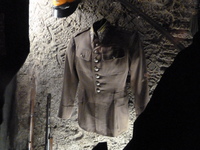 and then observed the German occupation
and then observed the German occupation
 which caused Nazi flags to be hung everywhere
which caused Nazi flags to be hung everywhere

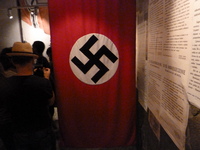 and statues to be destroyed, though part of this one was hidden
and statues to be destroyed, though part of this one was hidden
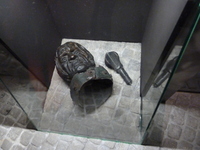 as this poster explained the situation
as this poster explained the situation
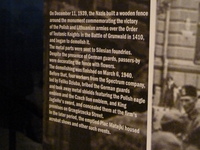 and we saw the first sign of Jewish rights being taken away
and we saw the first sign of Jewish rights being taken away
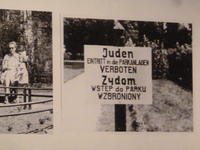 as we observed the trolley car
as we observed the trolley car
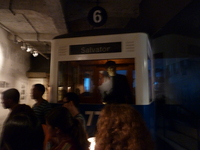 and heard about the professors at the local university being removed from their positions in an anti-intellectual campaign
and heard about the professors at the local university being removed from their positions in an anti-intellectual campaign
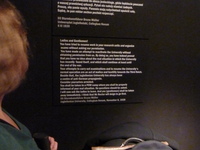 as the Nazis took control as we noted by the floor
as the Nazis took control as we noted by the floor
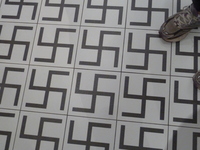
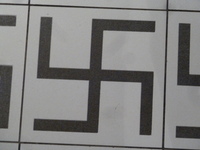
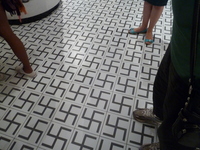 and wall decorations
and wall decorations
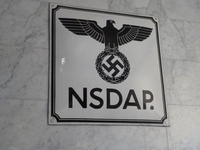 as Mitch and Alice stood on the frightening floor
as Mitch and Alice stood on the frightening floor
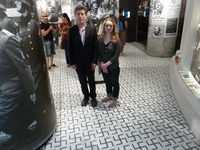 and we saw newsreels of the Nazis in power
and we saw newsreels of the Nazis in power
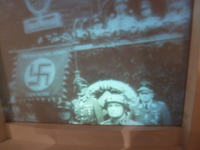
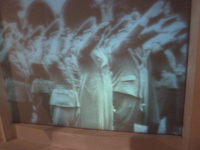 and as we passed this sign
and as we passed this sign
 we read about the Jews being displaced
we read about the Jews being displaced
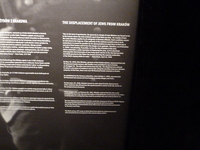
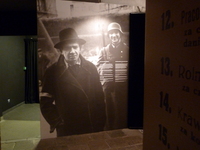 with sentences being carried out
with sentences being carried out
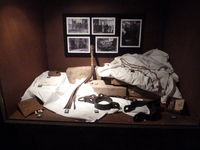

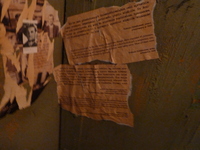 and arm patched being worn
and arm patched being worn
 with the wall being constructed even as Passover was being celebrated
with the wall being constructed even as Passover was being celebrated
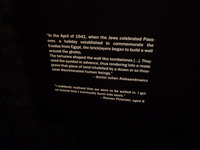 and visions of those who had faded from sight.
and visions of those who had faded from sight.
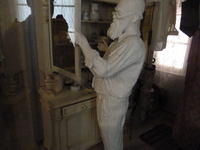
Next we saw the pots that Schindler's factory had made
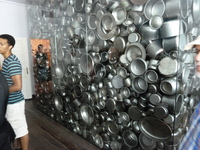 with the names of those he had saved
with the names of those he had saved
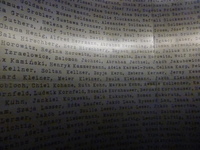
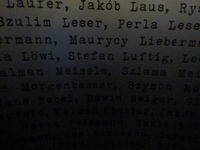 and the map over his desk
and the map over his desk
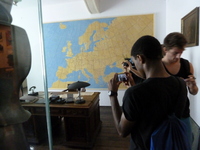 but the war effort was not going well for the Nazis
but the war effort was not going well for the Nazis
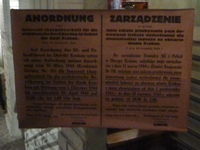 and these were the gifts possible for the last Christmas of the occupation
and these were the gifts possible for the last Christmas of the occupation

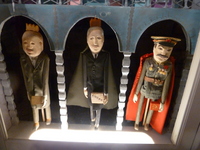
 but then Stalin took over and things didn't improve enough.
but then Stalin took over and things didn't improve enough.
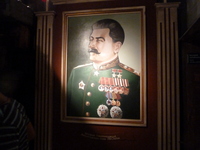
We were then escorted to a room that talked about choices
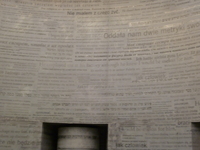

 and another that defined various attributes before leaving the museum.
and another that defined various attributes before leaving the museum.
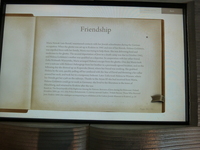 On the way back to town, we crossed this bridge that gave both air and road surface temperatures
On the way back to town, we crossed this bridge that gave both air and road surface temperatures
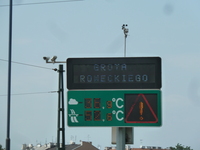 before we headed to the zapiekanka stand
before we headed to the zapiekanka stand
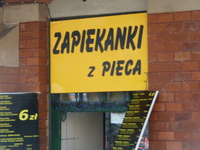 where we saw pigeons
where we saw pigeons
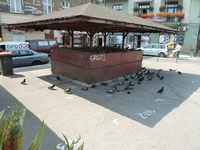 before approaching the stand
before approaching the stand
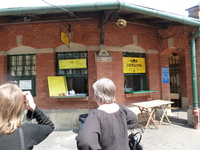 and choosing from a menu
and choosing from a menu
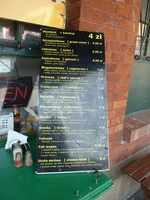
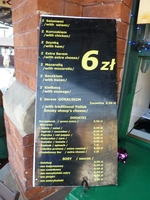 first a vegetarian
first a vegetarian
 and then a standard
and then a standard
 which I recorded as I ate
which I recorded as I ate
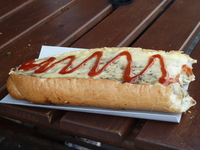
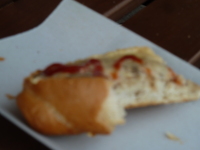
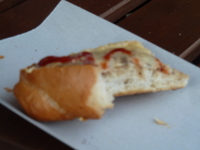 and after noting the the Gallerie d' Art Naif was closed
and after noting the the Gallerie d' Art Naif was closed
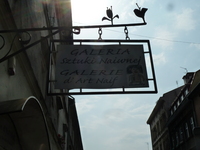 we purchased some liquids and came home.
we purchased some liquids and came home.
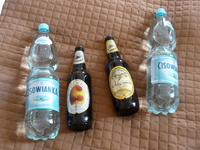
After a rest, we went out for the group dinner with special menu
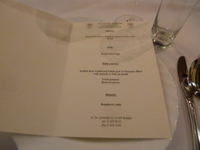
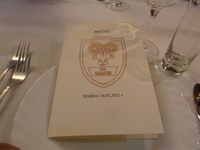 and before we ate, Tess sang opera for us
and before we ate, Tess sang opera for us
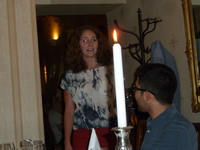 and then steak tartare arrived
and then steak tartare arrived
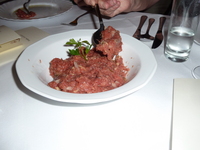 with bread
with bread
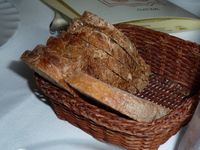 salad
salad
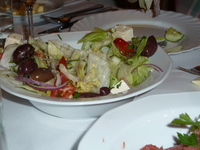 and salmon.
and salmon.
 Next came the soup
Next came the soup
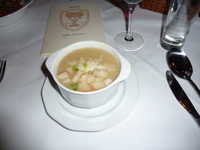 followed by the main courses of duck
followed by the main courses of duck
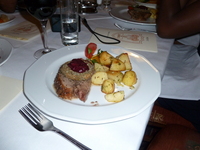 sole
sole
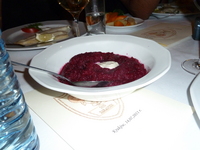 and pancakes
and pancakes
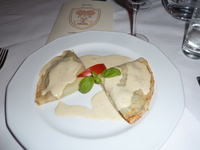 with beets
with beets
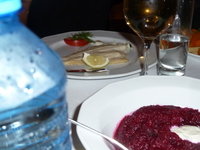 and followed by a dessert of raspberry cake.
and followed by a dessert of raspberry cake.
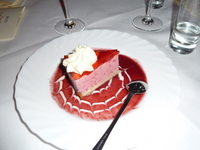
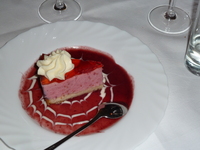
After saying hello to Barry the videographer, we decided to call it a night.

|



 before we went down for breakfast and I filled my plate
before we went down for breakfast and I filled my plate
 as Suzanne filled hers
as Suzanne filled hers
 and she
and she
 and I posed for portraits
and I posed for portraits
 before I explored and found signs for the hotel on their patio.
before I explored and found signs for the hotel on their patio.

 We greeted Mitch, Kathleen and Liam
We greeted Mitch, Kathleen and Liam
 before being introduced to the group and walking through our neighborhood
before being introduced to the group and walking through our neighborhood


 until we arrived at the gift shop
until we arrived at the gift shop
 outside the Remuh Synagogue
outside the Remuh Synagogue
 and we made our way past the memorials
and we made our way past the memorials

 into the sanctuary
into the sanctuary

 with the bemah in the middle
with the bemah in the middle
 and the ark with Torah scrolls
and the ark with Torah scrolls
 and a poster above the bemah giving the words to the aliyah
and a poster above the bemah giving the words to the aliyah
 as we left the bemah
as we left the bemah
 and headed to the cemetery where we saw the grave stone of the famous Rebe complete with notes left and stones of visitors
and headed to the cemetery where we saw the grave stone of the famous Rebe complete with notes left and stones of visitors


 and then explored the tombstones as
and then explored the tombstones as


 as our guide focused on our tombstone and explained the significance of what was written on it
as our guide focused on our tombstone and explained the significance of what was written on it
 and we then made our way through the cemetery
and we then made our way through the cemetery
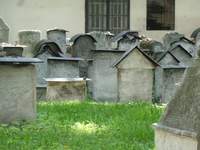
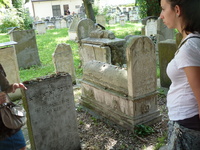
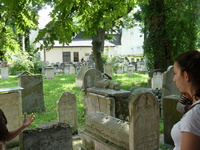
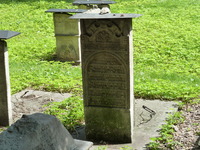
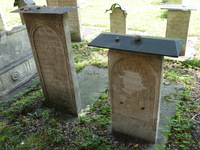
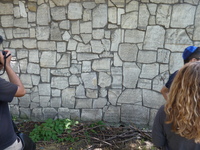
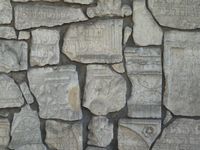
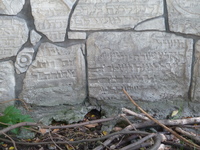
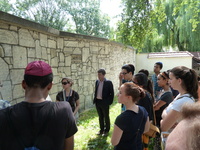

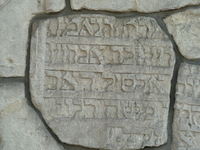


 and then saw some pieces of stones corresponding to Kahanim (and hence the hands).
and then saw some pieces of stones corresponding to Kahanim (and hence the hands).

 on the way out, I recorded this sad memorial
on the way out, I recorded this sad memorial
 and we headed to the town's memorial to the Jews who had perished
and we headed to the town's memorial to the Jews who had perished

 and the square (which is now filled with shops and restaurants largely owned by non-Jews)
and the square (which is now filled with shops and restaurants largely owned by non-Jews)
 and the synagogue
and the synagogue
 before capturing a final shot of the memorial
before capturing a final shot of the memorial
 and heading across the river to this plaza where the chairs had a special significance as I was to learn
and heading across the river to this plaza where the chairs had a special significance as I was to learn
 but first I noted this street scene which was the location of the resistance
but first I noted this street scene which was the location of the resistance
 as our group came onto the square which was at the heart of the ghetto
as our group came onto the square which was at the heart of the ghetto

 as we left this structure which had served as the police station for the Nazis who oversaw the ghetto
as we left this structure which had served as the police station for the Nazis who oversaw the ghetto
 and it was here that I learned that the chairs were an art installation dedicated to those who had been killed by the Nazis
and it was here that I learned that the chairs were an art installation dedicated to those who had been killed by the Nazis

 and we then walked down the street
and we then walked down the street
 and took the obligatory phone booth picture
and took the obligatory phone booth picture
 before we came to this sign
before we came to this sign
 defining the ghetto wall which had been made to look like tombstones to signify tot he Jews that this was their end.
defining the ghetto wall which had been made to look like tombstones to signify tot he Jews that this was their end.


 We were also shown windows that were bricked over as they were on buildings that were part of the ghetto and so could not have views to the outside
We were also shown windows that were bricked over as they were on buildings that were part of the ghetto and so could not have views to the outside
 and as we walked
and as we walked
 this sign seemed like an odd juxtaposition of the past and the present (or future)
this sign seemed like an odd juxtaposition of the past and the present (or future)
 and so we made our way to Oskar Schindler's factory
and so we made our way to Oskar Schindler's factory
 and saw the names of those he had saved
and saw the names of those he had saved


 before entering the museum
before entering the museum
 noting the price guide
noting the price guide
 and having some water, it being a hot day,
and having some water, it being a hot day,
 and seeing the kosher statement (which had just expired) for the coffee.
and seeing the kosher statement (which had just expired) for the coffee.





































































